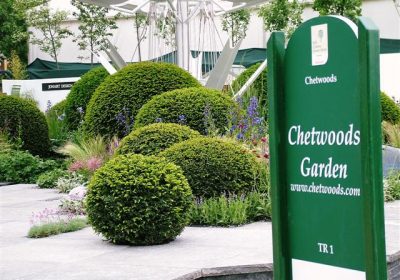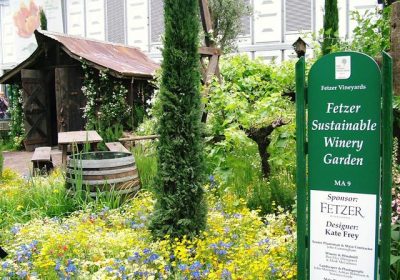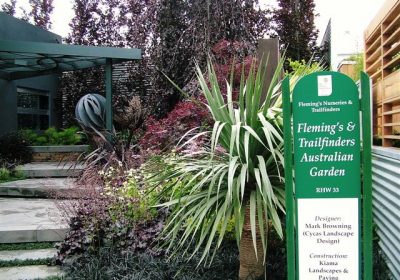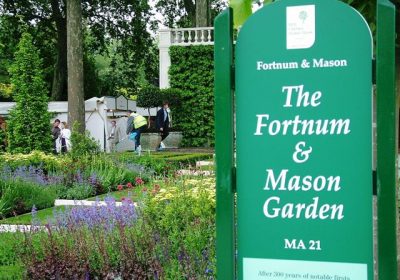Hasmead PLC Showcase Climatic Change Inspired Garden at Chelsea Flower Show 2007
Description
Upon receiving confirmation of space for a show garden at the Chelsea Flower Show 2007, Jonathan Todd, MD of Hasmead PLC said "I am delighted to have been accepted to build a show garden at the most important flower show in the world. I am especially excited about the climatic change theme of the garden designed by Chelsea newcomer Linda Bush. Gardeners have a responsibility to use nature’s resources appropriately and work with our climate not against it. The Hasmead landscape team are all looking forward to returning to the show after a three year break and with another strong conservation message which will be brought to life via Linda’s striking design”
Linda Bush left a City career to re-train as a garden designer, a graduate of the Inchbald School of Design, she has assisted on two gold medal winning Chelsea Flower Show gardens but this is her first major garden design for the show. On her sponsorship Linda commented, “Hasmead plc are award winning landscapers, having just received the BALI Grand Award for 2006, so I know I am in capable hands with the build of my garden. It’s up to me to deliver the goods and secure a medal. It’s wonderful to be given this opportunity and I’ll do everything in my power to bring back the gold.”
The Hasmead Sand and Ice Garden is a garden that highlights the growing issue of climatic change which results in two extremes – shrinking ice caps and expanding deserts. The soft flowing lines of the desert details are contrasted with the jagged edges of ice. The theme looks at how plants and gardeners need to adapt to climatic change, which plants to use and ways in which they can be used to cope with the increase in global warming that we are currently experiencing. The creation of the garden will include a carbon offset program making the Hasmead Sand and Ice Garden carbon neutral.
A large ice wall clothes one wall, representing slowly melting cracked ice. Boulders jut out at angles and moss, alpines and grasses merge and soften the edge between the ice and the surrounding planting. This area will be lit at night.
A series of curved dry-sandstone walls sweep down from the top of the rear boundary to ground level at the front of the garden. The silhouette of the rear boundary and the central wall echo the outline of rolling sand dunes. During the day the shadow of this central desert structure moves around the garden, advancing across the ice.
Key plants have a water-efficient character; ideal for areas which have periodic water shortages. All plants are suited to an open, sunny, well-drained garden. Some have the look of alpine plants, and some look more like desert plants. The plants range from icy colours such as white/silver to yellows for the advancing desert on the other side.
Touches of lilac and purple will provide contrast and lift, and architectural plants, such as Elaeagnus ‘Quicksilver’ and Stipa gigantea will add height, structure, and movement. Acacia trees along the rear boundary add a balance to the planting.
Everything but the Plants
Hasmead Sand & Ice Garden – Chelsea Flower Show 2007
Hasmead Sand & Ice Garden – Chelsea Flower Show 2007
The UK climate is changing, and extreme weather patterns are on the rise. No matter what the cause of this climatic change, we need to adapt to it. Linda Bush designed the Hasmead Sand & Ice Garden during the early days of the 2006 hose-pipe ban in Southern England, taking inspiration from the Dry Garden at RHS Hyde Hall and Beth Chatto’s Gravel Garden.
The Hasmead Sand and Ice Garden highlights two of the extremes resulting from climatic change: melting glaciers and expanding deserts. The soft flowing lines of the desert sands are contrasted with the jagged edges of ice. A focal point in the garden is a modern ‘ice’ wall covered in sharp icy-coloured Perspex ® from Lucite ® pieces. Water trickles down the ‘ice’ wall to represent slowly melting cracked ice. Sponsored by Lucite International, one of the world’s largest manufacturers of acrylic products, the ‘ice’ wall features Perspex from the company’s Frost and Vario ranges and is sure to be a talking point at the show.
On the other side of the garden the silhouette of the rear boundary and the central wall echo the outline of rolling sand dunes. During the day the shadow of the wall moves around the garden, advancing across the ice on the other side. The sweeping curves of the sand dunes support a bronze-coloured rill of water that cascades down the top of the wall to its base at the front of the garden. Blue coloured Perspex lines the rill to emphasise the colour of the water running off into the desert.
A series of dry-sandstone curved walls and paths sweep around the garden. These were inspired by the walls of Nijo Castle in Kyoto, Japan – a reminder of the Kyoto Global Warming Agreement of 1997 aimed at reducing emissions contributing to climate change.
The hand crafted pieces of stone vary from ‘soft sand’ shapes and colour on one side of the garden to ‘sharp ice’ on the other side.
Linda Bush has been working with Hasmead plc from the inception of the garden to set up a programme to offset the carbon footprint resulting from its creation. Most plant sourcing trips to Europe have been done by car rather than plane and wherever possible plants have been sourced in the UK. Leading landscape firm Hasmead plc has agreed to plant trees after the show to help reduce the carbon footprint even further. Director Simon Todd said ‘We have a responsibility to the planet to do whatever we can to keep harmful emissions to a minimum. Gardening is a huge pleasure for many of us and gardening responsibly is an option. Even simple things like planting more drought tolerant plants can have a huge impact on the amount of water we need to use on our gardens’.
Key Plants on the Hasmead Sand & Ice Garden
Chelsea Flower Show 2007
Chelsea Flower Show 2007
When choosing plants for the Hasmead Sand & Ice Garden, designer Linda Bush naturally selected plants that she knew to be as drought tolerant as possible, as the theme of the garden is to draw attention to climatic change and promote working with the climate in which we live, using plants that will thrive even with the increased periods of water shortages that we are experiencing as a result of global warming. The creation of the garden will include a carbon offset program making the Hasmead Sand and Ice Garden carbon neutral.
Asphodeline lutea is one of the key plants, whose tall stems bear whorls of grey-blue, grassy leaves and spikes of up to 1.2m tall. The bright yellow fragrant star-shaped flowers emerge to give a vertical accent in the garden from late spring to early summer. Linda will plant them in blocks to add height and ‘hot’ floral colour on the Sand side of the garden. The stems become beaded with green cherry-like fruits, which later turn brown leaving attractive seed-heads, and the leaves die down and disappear after mid-summer and re-shoot in early autumn. This clump forming hardy herbaceous perennial is native to the Mediterranean area, and its swollen rhizomatous roots help it to withstand dry conditions. This frost hardy (-5°C), sun loving plant can grow to a height of 1.2 m with a spread of 50 cm.
Elaeagnus ‘Quicksilver’ is a fast-growing deciduous small tree or large shrub that grows to a height & spread of 1 x 1 m after 5 years and ultimately to 4 m x 4 m. Selected for its silvery foliage and the movement that it will add to the garden when windy, this shrub forms an upright plant or can be pruned to form a bushy dome. Sweetly scented small, creamy flowers appear in early summer. Native to South Europe and Asia, it is very drought tolerant, frost hardy, prefers full sun and requires fertile, well-drained soil.
Euphorbia myrsinites, an evergreen, prostrate perennial adds form and colour to the garden throughout the year. Trailing stems of fleshy blue-green leaves can be up to 35 cm long and the large heads of lime-green flowers are a delight in spring and should give a good show on the garden at the Chelsea Flower Show. Euphorbia myrsinites prefers sun and well drained soil, can grow to a height of 8 cm and a spread of 20 cm and is frost hardy to -5°C. Linda will plant them along the top of a dry-stone wall where they will be easily visible, and will trail over the edge.
With its diverse ever changing colour palate Libertia peregrinans was an obvious choice for a drought tolerant garden. It is a rhizomatous clump-forming evergreen perennial grown for its foliage, decorative seed pods and flowers. Individual fans form clumps of very narrow, stiff leaves with wide central veins stained orange. The entire plant gives off an orange glow, especially in winter but white flowers bloom in early to mid summer followed by yellow to orange seed capsules, so it is an ideal plant to use on the Sand side of the garden. Native to South America, Australia and New Zealand, the Libertia peregrinans needs a sheltered, sunny or partially shaded site and well-drained soil.
Stipa tenuissima is one of the finest textured of all ornamental grasses. A versatile deciduous plant of up to 60 cm, it is ideal for a sunny gravel garden and perfect for introducing movement into a planting scheme since the wispy, fluffy flower-heads and fountain of hair-like leaves billow in the slightest breeze. Blooming June to September, the inflorescences become light straw-coloured through the season, remaining attractive into winter. As the mature heads fall outwards, new ones replace them retaining a beautiful transparent screen of flower-heads. Native to dry open ground, open woods, and rocky slopes in Texas, New Mexico, Mexico, and Argentina, Stipa tenuissima is very drought tolerant, easily grown on well-drained soil in full sun or light shade and frost hardy.





